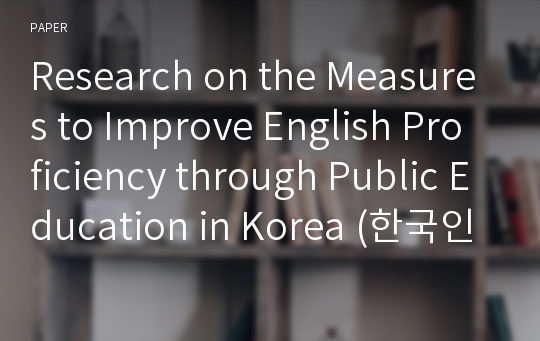Research on the Measures to Improve English Proficiency through Public Education in Korea (한국인의 영어 구사 능력 향상을 위한 공교육 개선 방안 연구)
*가*
다운로드
장바구니
* 본 문서는 PDF문서형식으로 복사 및 편집이 불가합니다.
소개글
본 논문은 한국의 영어교육이 학습자의 의사소통 능력 향상을 위해 지향해야할 방향과 방법을 제시하는 것에 그 연구 목적을 두고 있으며, 그 주장하는 바를 뒷받침 하기 위해 한국 영어 교육의 역사, 다양한 교수법 이론과 적용, 해외와 국내의 참고할 만한 사례들, 교육과 관련된 다양한 기존의 연구 등의 자료들을 근거로 두고 있다. 본 논문은 현재 영어교육을 전공하고 있거나 영어 교육에 관심이 있는 사람들에게 영어교육과 관련된 개괄적이고 폭 넓은 이해의 틀을 제공하는 것은 물론 향후 더 깊이 있는 연구를 위해 살펴야 할 방향을 제시해 줄 것이다.본 논문은 영문으로 작성되어 있으나 영어교육을 공부하는 사람이라면 이해에 어려움이 없을것이라 생각한다.
목차
Chapter I. IntroductionChapter II. The Causes of Low Efficiency of English Education in South Korea
II.1. The Material Motivation for Learning English
II.2. A Large Number of Students in One Classroom
II.3. The Grammar-Translation Method
Chapter III. Theories and Methods to Improve the Efficiency of English Education in Korea
III.1. The Communicative Language Teaching
III.1.(1). The Natural Approach
III.1.(2). The Content-Based Approach
III.1.(3). The Task-Based Approach
III.2. The Direct Method
III.3. Applying the Open Education
Chapter IV. The Realistic Approaches to Bring the Methods to the Classrooms in Korea
IV.1. The Example of Denmark
IV.2. The Example of Finland
IV.3. Examples in South Korea
IV.3.(1). Global Vision Christian School
IV.3.(2). Younghoon Elementary School
IV.3.(3). Korean Minjok Leadership Academy
IV.3.(4). A Study on Teaching Science in English in Korea
Chapter V. Suggestions and Conclusion
References
Additional Sources
Table 1.
Table 2.
Table 3.
Table 4.
Table 5.
Table 6.
Table 7.
Table 8.
Table 9.
Table 10.
Appendix 1.
Appendix 2.
Appendix 3.
Appendix 4.
본문내용
한국인들은 매년 영어 학습에 막대한 시간과 돈을 투자하고 있으나 그 투자의 효율성에는 항상 의문이 제기된다. 특히 영어를 말로 구사하는 부분에서 여전히 개선의 여지가 많은 것이 사실이다. 본 연구는 한국인들의 영어 학습이 그 투자하는 시간과 비용에 비해 효율적이지 못한 원인에 대해 생각해 보고, 이를 개선 하기 위해 다양한 교수법과 이론들을 이 나라의 공교육 현장에 적용할 수 있는 방안을 찾는 것에 목적이 있다. 그 방안을 찾기 위한 바탕이 되는 이론들로는 Chapter 3에서 의사소통 중심 교수법의 자연적 접근, 내용중심 접근 그리고 과업중심 접근법과 직접식 교수법 그리고 열린교육의 응용이 제시되어 있다. 이 이론들의 현실적 적용을 위한 방향을 찾기 위해 Chapter 4에서는 먼저 성공적인 영어 교육의 사례들을 제시하였다. 첫 번째 사례는 한국과 유사한 문법-번역식 교수법을 20세기까지 사용하였고 한국과 비슷한 영어교육의 문제점을 안고 있었으나 현재는 국민 대다수가 영어를 능숙하게 구사할 만큼 성공적인 영어교육을 제공하고 있는 유럽의 두 국가 덴마크와 핀란드의 영어교육 제도이며, 두 번째는 같은 입시제도를 공유하는 한국 내에 있으면서도 영어로 영어 및 타 과목들의 수업을 진행하고, 이 경우 발생하는 문제점들에 대한 한국 실정에 맞는 해결책을 스스로 찾아온 학교들인 Global Vision Christian School, 영훈 초등학교, 민족사관고등학교의 사례이다. 마지막 사례는 순천시교육청이 과학 영재 학생들을 대상으로 시행한 영어로 과학 수업을 진행했을 때 학생들의 영어 실력 향상에 미치는 영향에 대한 실험연구이다. 이상의 사례들을 살펴봄으로 Chapter 5 에서는 영어로 영어과목 및 타 과목들을 가르치기 위해 필요한 요소들과 예상되는 어려움들을 짚어보고 어떻게 덴마크나 핀란드와 같은 영어교육 제도를 한국의 학교에 적용시킬 수 있을지에 대한 제안들을 제시한다.참고 자료
Choi, S. (2003). The Cultural Capital Research on English Fluency in South Korea: Focused on English Learning of University Students and Their Perceptions of Fluent English Speakers. Ewha Joural of Social Sciences. Seoul: Research Institute for Social Sciences College of Social Sciences Ewha Womans University. P. 11.Choi, Y. (2014). A Study on the Improvement of English Proficiency through English Immersion Science Class for Science-Gifted Middle School Students. M.A. Thesis. The Graduate School of Education Sunchon National University. pp. 19, 25, 26, 27, 33.
Hwang, H. (2008). Study on English Immersion Education: Based of a Case Study of Foreign Countries and Survey on Public. M.A. Thesis. Kyungpook National University. pp. 32, 58, 78.
Hur, S. (2003). A Meta-Analysis on the Effects of Class-Size Reduction. The Journal of Education. Incheon: The Elementary Education Research Institute of Gyeongin National University of Education. Vol. 21. 69-101.
Jeong, J. (2007). A Study on the History of English Education in Korea. M.A. Thesis. Hongik University. pp. 6, 11, 20, 23.
Kang, J. (1981). Ideas of Enlightenment in Chosun. Seoul: Bibongchulpansa. p. 276.
Kim, J.D. (2008). Comparative Analysis of Anti-bullying Policies in the state of New South Wales, Australia and Kyunggi Province, South Korea. Journal of Asia-Pacific Studies, Vol.15. No.2. 269-293. p.280.
Kim, J.H. (2008). The Development Directions of English Education Based on the Communication Abilities. M.A. Thesis. Hongik University. pp. 8, 9, 10, 30, 32, 33.
Kim, M. (2008). A Study on Communicative English Language Teaching in Singapore, Denmark and Finland: With Its Implications in English Education in Korea. M.A. Thesis. Incheon National University. pp. 16, 22, 23, 47, 50, 57.
Kwon, S. (2009). A Study on Desirable English Immersion Program in Korea. M.A. Thesis. Kyungwon University. pp. 23-56.
Lee, J. (2009). A Study on SLA Theories reflected in the Korean English Curricula. M.A. Thesis. Sungkyunkwan University. pp. 38, 42. 46, 51.
Lee, M. (2004). English Education and its Methods at the End of Chosun Dynasty. Thesis Collection. Suwon, South Korea: The University of Suwon. Vol.22. 49-59. pp. 50, 52.
Lee, Y. (1998). Problems and Suggestions for improving in Teaching Methods. The Journal of Curriculum Studies. The Korean Society for Curriculum Studies.Vol.16. No.1. 131-195. pp. 132, 133, 135, 136, 152, 159.
Mun, Y. (1976). English Education of Late Josun Period. English Teaching. The Korea Association of Teachers of English, p. 8.
Park, H.J. (2009). A Suitable English Immersion Model for Korea. M.A. Thesis. Sungkyunkwan University. pp. 44, 45, 49.
Park, H.W. (2012). The English Education Problems in View of Native English Teachers in Korea. Ph.D. Dissertation. Mokwon University. p.55.
The Ministry of Education (1955). Junior high school Curriculum (The Ministry of Education Decree No.45).
The Ministry of Education (1963). Junior high school Curriculum (The Ministry of Education Decree No.121).
The Ministry of Education (1963). Commentary on Senior high school Curriculum.
The Ministry of Education (1973). Junior high school Curriculum (The Ministry of Education Decree No.325).
The Ministry of Education (1981). Junior high school Curriculum (The Ministry of Education Decree No.442).
The Ministry of Education (1987). Junior high school Curriculum (The Ministry of Education Decree No.87-7).
The Ministry of Education (1987). Guidelines for Curriculum Standard (Kindergarten, Elementary school, Junior and Senior high school).
The Ministry of Education (1992). Senior high school Curriculum(I)
The Ministry of Education (1992). Junior high school Curriculum (The Ministry of Education Notification No.1992-11)
The Ministry of Education (1994). Commentary on Junior high school Curriculum (Based on the Ministry of Education Notification No.1992-11)
The Ministry of Education (1997). Curriculum for Teaching Foreign Languages (I) (The Ministry of Education Notification No.1997-15)
The Ministry of Education (1999). The Level-based Curriculum of the 7th Revised Curriculum.
The Ministry of Education (2007). The 2007 Revised Curriculum.
Alesandrini, K. & Larson, L. (2002). Teachers Bridge to Constructivism. New York: The Clearing House, pp. 119-121.
Bell-Gredler, M. E. (1986). Learning and Instruction: Theory Into Practice. New York: Macmillan. p. 160.
Bourdieu, P. (1986). 'The Forms of Capital', in Richardson, John G., ed., Handbook of Theory and Research for the Sociology of Education, New York: Greenwood. p. 47.
Brown, H.D. (2000). Principles of Language Learning and Teaching. White Plains. NY: Longman. pp. 287–288.
Cakir, M. (2008). Constructivist Approaches to Learning in Science and Their Implications for Science Pedagogy: A Literature Review. International Journal of Environmental & Science Education, Vol.3. No.4. 193-206. Retrieved from EBSCOhost.
Ellis, N.C. (2006). Cognitive Perspectives on SLA. University of Michigan. p. 101.
Ellis, Rod (1997). Second Language Acquisition. Oxford Introductions to Language Study. Oxford, New York: Oxford University Press. pp. 47–48.
Finn, J.D. (1998). Class size and student at risk: What is known? What is next?. A Commissioned Paper. Washington D.C.: National Inst. on the Education of At-Risk Sudents. pp. 3, 6.
Garcia, M. (2014). Functional Notional Approach. Retrieved from
https://prezi.com/s52pfsssfgim/functional-notional-approach/
Gilmore, G.W. (1892). Korean from its Capital. Philadelphia: The Presbytorian Board of Publication, pp. 228-230.
Grider, C. (1993). Foundations of Cognitive Theory: A Concise Review. U.S. Department of Education, Office of Educational Research and Improvement. pp. 2-3.
Hymes, D.H. (1989). ‘Ways of speaking’, in R. Bauman and J. Sherzer (eds) Explorations in the ethnography of speaking, 2nd edition. Cambridge: Cambridge University Press, pp. 433-51.
Johnstone, B. & Marcellino, W. (2010). Dell Hymes and the Ethnography of Communication. A Sage Handbook of Sociolinguistics. London: Sage Publishing, p. 3.
Krashen, S.D. & Terrell, T.D. (1995). The Natural Approach: Language Acquisition in the Classroom. Hertfordshire, U.K.: Prentice Hall Europe. p. 58.
Krashen, S.D. (1985). The input hypothesis: Issues and implications. New York: Longman. p. 34.
Larsen-Freeman, D. & Anderson, M. (2000). Techniques & Principles in Language Teaching. Oxford, pp. 13-115.
Lenneberg, E. H. (1967). Biological Foundations of Language. New Jersey, U.S.:Wiley. p. 158.
OECD (2007). The Programme for International Student Assessment (PISA).
Richards, J. C. & Rogers, T. S. (1986). Approaches and methods in language teaching: A description and analysis. Cambridge, UK: Cambridge University Press. p. 17.
Richards, J. C.; Schmidt, Richard, eds. (2002). "Interaction Hypothesis". Longman dictionary of language teaching and applied linguistics. London New York: Longman. p. 264.
Richards, J. C. (2006). Communicative Language Teaching Today. New York: Cambridge University Press. p. 3.
Vlack, S.V. (2010). Second Language Learning Theories. Sookmyung Women's University. (udveksling.com)
Western Town College (2006). Become the Teacher of your Dreams. Toronto: pp. 42-50.
Newspaper Article
Changhoon Jeon, March 24. 2008. Maeil Newspaper.
(http://www.imaeil.com/sub_news/sub_news_view.php?news_id=13137&yy=2008)
Eunhye Kang, August 28. 2015. edaily.
(http://www.edaily.co.kr/news/NewsRead.edy?SCD=JG21&newsid=0*************912&DCD=A00702&OutLnkChk=Y)
Heegyoon Kim, November 6. 2013. Dong-A Ilbo, A 13.
Hyeongkyu Hwang, January 24. 2008. Maeil Business Newspaper.
(http://news.mk.co.kr/newsRead.php?year=2008&no=44252 )
Jongbin Ban, April 18. 2007. Yonhapnews.
(http://www.yonhapnews.co.kr/photos/1991000000.html?cid=GYH*************0044&from=search)
Sangmi Kim, July 26. 2012. Yonhapnews.
(http://www.yonhapnews.co.kr/bulletin/2012/07/25/0200000000AKR*************0004.HTML)
The Social Survey on Consciousness and Living of University Students (2002), Joint Social Research Team of Seoul National University, EwhaWomans University, Chonbuk National University, Kookmin University, Hallym University, Donga University.
http://blog.naver.com/marry1219?Redirect=Log&logNo=220109048888 (2016)
http://cafe.naver.com/20daelee/159132 (2016)
http://cafe.naver.com/kickstudy/721560 (2016)
http://en.wikipedia.org/wiki/Cultural_capital (2016)
http://global.britannica.com/topic/language (2016)
http://global.britannica.com/topic/transformational-grammar (2016)
http://subclear.tistory.com/163 (2016)
http://udveksling.com (2015)
https://web.stanford.edu/~hakuta/www/LAU/ICLangLit/NaturalApproach.htm (2016)
http://www.ef.co.kr/epi/ (2015)
http://www.kostat.go.kr (2015)
http://www.moe.go.kr (2015)
Han, H.S. (2004). How to Teach a Foreign Language by Otto Jespersen. Seoul: Hankookmunhwasa.
Han, H.S. (2005). The Hypocritic Rings of Discourse on English. Paju, Korea: Thaehaksa.
Jin, K.A. (2006). The Innovation Measures of English Education. Seoul: Korea Educational Development Institute.
Jin, K.A. (2007). Finnish Who Speak a Language with the Same Structure as Korean Learn Listening, Reading, Speaking and Writing in Elementary School: English Education in Finland. Kyoyookmadang21. Seoul: The Ministry of Education. Vol.299. p.120-1.
Kim, H.S. (1999). Research on the History of English Education and its Direction of Improvement. M.A. Thesis. Hongik University.
Yoo, B.H. (1992). Research on the History of Progress of Education in Korea. Seoul: Kyohakyonkusa.
Brown, H.D. (1987). Principles of Language Learning and Teaching. London: Prentice Hall, p. 57.
Breen, M. (1987). Learner contributions to task design. In C. Candlin & D. Murphy(Eds.), Language learning tasks. Englewood Cliffs, NJ: Prentice Hall.
Ellis, N.C. (2002a). Frequency effects in language processing: A review with implications for theories of implicit and explicit language acquisition, Studies in Second Language Acquisition, Vol.24. No.2. 143-188.
Ellis, N.C. (2002b). Reflections on frequency effects in language processing, Studies in Second Language Acquisition, Vol.24. No.2. 297-339.
Krashen, S.D. (1987). Principles and practices in second language acquisition. New York: Prentice-Hall.
Littlewood, W. (1983). Communicative Language Teaching. Cambridge: Cambridge University Press.
Mohan, B. A. (1986). Language and Content. Boston, U.S.: Addison-Wesley.
Underwood, H.H. (1926) Modern Education in Korea. The International Press, New York.




























